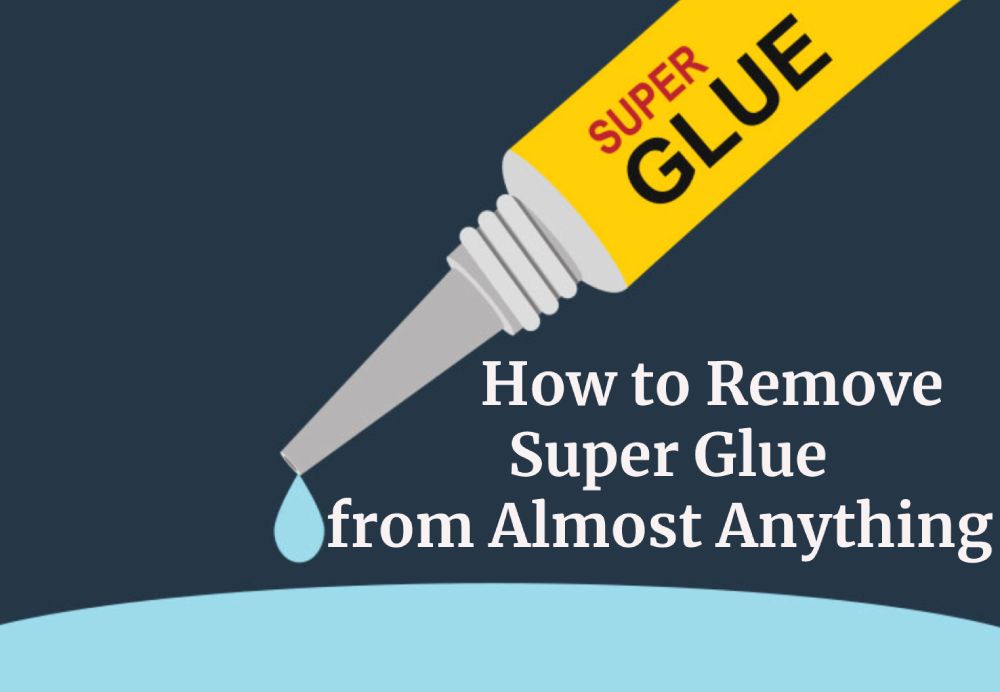Remove super glue and Gorilla Glue with these expert tips.
Super glue and Gorilla Glue can fix almost anything, including broken metal, ceramic, leather, rubber, vinyl, and some plastics. Those who have ever used ultra adhesive solutions know how challenging it can be to remove super glue. Guy Peters, owner and founder of MOP STARS, said that super glue is extremely difficult to remove due to its strength. In fact, a 1-square-inch bond can hold more than a ton! It is no wonder that it is difficult to remove.
To make matters worse, it sets so quickly that it’s even more alarming. While most glues take minutes (or longer) to set and create a strong bond, super glue can form one in just a few seconds. The chemical reaction that creates the super glue bond requires only a small amount of water. As well as being everywhere, water is in the air in the form of humidity and on our hands, the surface we’re gluing to, and even on the surface we’re gluing to. “This is why super glue creates such a strong bond in just a few seconds and why it can be so difficult to remove,” he explains. Some Gorilla Glue formulas have different main ingredients, but it still works the same way, setting in less than a minute.
“If you are not careful, you may end up removing more than you bargained for,” warns Peters when it comes to using acetone to remove nail polish. As well as being a great solvent for super glue, acetone can also remove wood finishes, paint from walls, dissolve plastics, and even damage fabrics.” So while acetone will do the trick, you also need to take into account the surface you’re working on. Furthermore, acetone is extremely flammable, so you should use it with caution.
How to remove super glue depends largely on the type of surface you are trying to remove it from. The use of acetone, one of the more popular solutions, might result in you removing the finish from your hardwood floors too if you’re trying to remove super glue. Here’s how to remove stains that seem impossible to remove (but aren’t).

Table of Contents
What removes super glue?
It will depend primarily on the surface when choosing how to remove super glue. I have compiled a list of items that will work.
- Remover for nail polish
- The acetone
- The use of rubbing alcohol
- Sanitizer for hands
- Using sandpaper
- Vinegar of white color
- (For skin) Soapy water
- The best oil for skin is olive oil (in small quantities)
- Fluid for lighters
- The nitromethane gas
How to get super glue off skin
Despite dozens of “hacks” for removing super glue from your skin, The Original Super Glue says soap and water are the best way to do it. You can do this by following these steps:
- Apply warm soapy water vigorously to the area. Peters says that soap can help break up the bond a little, but it will take time.
- Consider using a sponge or washcloth to scrub the area, but be gentle and use light pressure.
- Lightly scrub the area until the glue starts to flake off. “Be careful with large pieces so you do not accidentally pull the skin off,” he advises. Be prepared to wash this stuff several times since it is strong.
How to remove super glue from glass
As super glue is pretty durable, removing it from glass shouldn’t be a problem with any of the more powerful solvents on this list. Your best option is acetone/nail polish remover followed by rubbing alcohol-based products, according to Peters. You can also use lighter fluid to remove nail polish from certain surfaces.
The steps are as follows:
- When working with sturdier glass, apply the solvent (acetone, nail polish remover, rubbing alcohol, etc) to a cotton ball or cloth.
- Make some circles with vigorous pressure while blotting the area.
- Allow it to sit for several minutes if it does not come off right away.
- As necessary, repeat.
How to remove super glue from plastic
According to Peters, plastic is one of the toughest materials to remove super glue from. “The problem is that many solvents (especially acetone) that remove super glue also dissolve, damage, and possibly destroy plastic,” he says. “If you’re dealing with a sturdy plastic or only a little super glue, you can use only a little acetone. If you’ve got a bigger super glue problem, you might need to get more creative.”
It is recommended that you use something called nitromethane, which can be found in some specialty hobby stores; you can also find super solvents with similar ingredients online, such as Satellite City Super Solvent, which is available from Krazy Glue. “Be aware that plastics react differently, so always start with a hidden or non-critical area before trying any method,” Peters warns.
How to get super glue out of clothes
In most cases, it’s best to avoid using acetone when it comes to removing super glue from clothing. According to Peters, rubbing alcohol will work on cotton and polyester fabrics. Even wool can handle some rubbing alcohol, but leather requires a different approach.
Consider using vinegar to remove super glue from leather since it can be less harsh but still effective. “It might take a bit more time and a bit more vigorous application than some other compounds, but it should do the trick,” Peters says.
Is there another, more surprising option? An anti-freeze product. WD-40 loosens the glue so it can be removed. One of the reasons I like this option is that WD-40 is actually good for leather and can be used to soften it,” Peters says. In addition to removing the glue, you can also give your leather a bit of a tune-up. Discover more unusual uses for WD-40.
Apply rubbing alcohol, vinegar, or WD-40 to a clean cloth and scrub vigorously until the superglue starts to come off.
How to get off upholstery and carpet
For most fabrics and carpets, acetone should be avoided when removing super glue from upholstery. According to Peters, acetone can remove color from carpet, so you could go from a stiff spot of super glue to a bleached-out circle. In this case, rubbing alcohol is a better choice, and most carpets can handle it without problems. It is always a good idea to test a hidden spot first. In addition, he recommends avoiding things like vinegar for carpets since it can easily soak in and leave a lasting smell. Here are some tips for removing nail polish from carpet.
How to remove super glue from metal
The removal of super glue from metal is usually easier since metals can withstand acetone without issue, according to Peters. When using acetone, be careful not to get it on anything else nearby.
How to remove super glue from wood
Whether the wood is finished or unfinished is the first consideration. “Unfinished wood is easy to finish—just apply acetone,” Peters says. Acetone can actually remove the finish from finished wood, however. In addition to looking strange, this could have an adverse effect on the wood’s life. If you’re very careful, you can apply acetone to the superglue area with a q-tip. For small spots, this works great.”
If you don’t want to risk it, try a product containing nitromethane. “It’s specifically designed to remove glue,” he says. Mineral oil can also help loosen the glue so you can scrape it off.
Other tips for removing super glue
Peters recommends scraping off super glue before using a solution to remove it. Occasionally, scraping the glue off is the best option, says Peters. Stretching and wiggling pliable materials like cloth will break up glue. With a razor blade or even sandpaper, you can scrape off glue from harder materials like wood, metal, and some plastics.
Use Q-Tips to your advantage. Q-tips can be used to apply acetone or other solvents to small areas of super glue. You can apply plenty of acetone with Q-tips, but Peters warns that there is no risk of overdosing. If you’re careful, you can use this technique to remove glue from sensitive surfaces like plastic and finished wood by getting the acetone only on the glue itself. Just be careful!”
